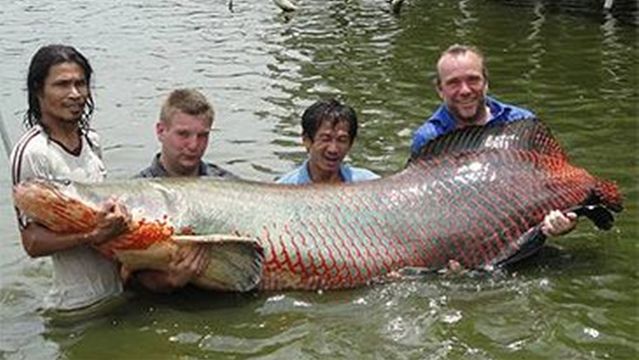There is a kind of big fish in South America that is not afraid of piranhas. Not only that, they eat piranhas. This big fish that can easily prey on piranhas is the Arapaima, also known as the walrus fish.

Arapaima is a remnant of ancient freshwater fish, which is estimated to have appeared 100 million years ago.Arapaima has a very unique body structure, and the most prominent feature is its sharp "teeth". Like most freshwater fish, Arapaima has small and thin teeth. But it does not rely mainly on small teeth to hunt, and surprisingly uses the tongue, which should be a taste organ, to hunt. In human common sense, the tongue of any animal is made of relatively soft muscle tissue. However, the tongue of the Arapaima is a hard bone-like object covered with strong and sharp "teeth", which is why it is named "Arapaima".
Arapaima is mainly distributed in the river beaches of the Amazon River Basin, but the exact age of its distribution, especially in the lower part of the basin, is unknown. It was first recorded in the Essequibo basins of Guyana, and there is fossil evidence that its history exists in the Magdelena River basin in Rio de Janeiro, Colombia. Outside its native range, Arapaima has been introduced to rivers and fisheries in Asia, and is also artificially raised in various aquariums for viewing.
Arapaima has great brute force. Using its tail as a weapon, it can easily knock down an adult male and break bones and cause a lot of internal injuries.
Arapaima often lurks under obstacles on the water surface, waiting for an opportunity to open its huge mouth and inhale forcefully. It sucks prey into its mouth through huge suction like a vacuum cleaner, and then kills it with its hard tongue. After being killed, the prey directly enters the digestive organs through the esophagus for digestion.
The scales of Arapaima are extremely strong. The indigenous people of South America will grind the scales of captured Arapaima and use them as daggers. It even inspired scientists to start developing new types of bulletproof vests.
On February 27, 2015, four Thai men spent two hours to catch a 460-jin Arapaima, setting a world record.
Arapaima has huge economic value. An Arapaima has an average of 70 kilograms of fish meat. In Brazil, local residents can hunt a certain number of Arapaima for food with the permission of the local government, but there are strict restrictions on the number and size of the fish. The scales are large and hard and can be sharpened into claw knives. It has a large and beautiful appearance. It is often used as an ornamental fish. The meat can be made into dried or salted products, which is a popular food in the production area. The teeth can be used to replace files after being dried. In South America, the tongue of Arapaima is used to grind into powder and drink it with guarana mixed with water, which is said to kill roundworms.
Arapaima has another nickname called "silly roe deer in the water" because of its touchingly low IQ and strong curiosity. If there is any movement or sound on the water, they will join in the fun. So the way Brazilian locals catch Arapaima is very simple. They drive a small boat on the river to make some noise, wait for the fish to stick its head out and come over, and then hit it with a stick.
Perhaps it is too easy to catch, and the fish meat is delicious without small bones, so the locals are crazy about catching Arapaima. So in the 1970s, the number of Brazilian Arapaima in the Amazon Basin began to decrease. In recent years, the indiscriminate logging of the Amazon rainforest by humans has also exacerbated the decrease in the number of Arapaima to a certain extent. With such a sharp decline in wild catches, the domestication of this fish is gradually developing in the Amazon River Basin of Brazil and Colombia to alleviate this.
Arapaima is a giant air-breathing fish, with some specimens reaching several hundred kilograms and sometimes exceeding four meters in length in adult stage. The fish has been intensively fished since the early eighteenth century for its tasty, boneless flesh. A century ago, more than 1,200 tons of Arapaima were caught annually in the Brazilian port of Belém alone. In 2006, only 380 tons were reported for the entire Amazon basin. Today, estimates of the wild population of Arapaima range from 50,000 to 100,000 individuals.
Listed in the IUCN Red List of Threatened Species (IUCN) 1996 ver2.3 - Data Deficient (DD).
Protect wild animals and stop eating game.
Maintaining ecological balance is everyone's responsibility!